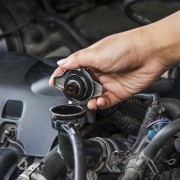If you drive a manual transmission vehicle, replacing your car's clutch can be costly. Here's some advice to help your clutch last longer that could save you money on repairs.
- Browse Categories
- All Tips
-
Home & Garden
- All
- Appliances
- Bathroom
- Cleaning
- Crafts
- Decorating
- Electrical
- Flooring
- Furniture
- Garage Door
- Gardening
- Green Living
- Heating
- Home Alarm Systems
- Home Maintenance
- Home Remedies
- Home Security
- Home Staging
- House Sitting
- Junk Removal
- Kitchen
- Lawn Care
- Lock Systems
- Moving
- Outdoor Living
- Pest Control
- Plumbing
- Renovation
- Roofing
- Snow Removal
- Storage
- Tools
- Tree Service
- Health
- Family
- Travel
- Auto
- More Tips

5 ways to extend the lifespan of your car's clutch
October 28, 2014

The way you drive can have a significant effect on how long your clutch lasts. Since a new clutch can cost you upwards of $1,000, owners of manual transmission cars should try to keep their clutches in good condition. While following the car manufacturer’s instructions is the best way to make any car part last longer, here are a few ways to keep your clutch in good working order for an extended length of time.
1. Don’t ride the clutch
This is the first rule of long clutch life: avoid keeping your foot on the clutch.
- The clutch pedal should be either all the way depressed or untouched entirely. Otherwise, you’re creating extra wear on a very expensive car part.
2. Don’t use the clutch to keep from rolling backwards on a hill
Keep from rolling backwards when you’re starting from a stopped position on an incline by using the handbrake until you engage the clutch. Then, shift into first gear and reach about 3,000 RPM.
- Next, slowly release the clutch followed by the handbrake as you bear down on the throttle.
3. Don’t keep driving full-tilt when you see a red light ahead
Begin slowing down in advance when you see stopped traffic, a red light or another reason you’re going to have to stop ahead.
- By the time you reach the traffic or intersection, you might not need to stop at all, allowing you to drop the clutch on your idling engine and avoiding clutch slippage.
4. Don’t drive away from a stop light like there's a fire
Keep those RPMs low as you pull away from a stopped position.
- About 1,100 RPM should do the trick.
- Avoid revving the engine and be sure not to slip the clutch more than necessary.
5. Don’t use the clutch to save your brakes
Your clutch costs more to replace than brake pads do. Use the clutch as intended.
- Match your engine’s speed to the rear-wheel speed for smoother downshifting.
- Raise the vehicle’s RPM by engaging the throttle a bit as you release the clutch when downshifting.
- Doing so will not only save wear on your clutch, but it will also make the transition smoother.
Some drivers use their heel on the brake pedal and their toe on the throttle, applying both at the same time, for smoother downshifting.
- This method takes some practice and should never be applied in traffic until you’re quite experienced and comfortable with manual transmission driving.






